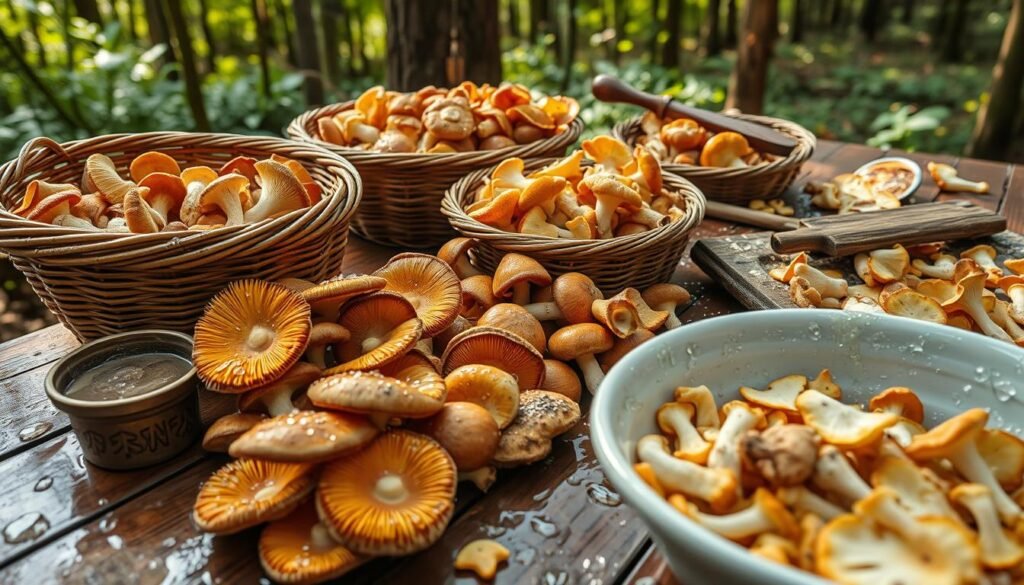What makes mushroom processing both an art and a science? It’s the careful steps from growing mushrooms to slicing and packaging them. Each step needs a deep understanding of the process. We’ll look at how mushroom processing works, from handling to storage, to keep losses low.
The convenience food sector, which includes mushrooms, has grown a lot. In 2022, it reached $562.2 billion, with China making a big impact, adding $126.5 billion.
We aim to explain the journey from harvest to market. We’ll cover the techniques and technologies used, like slicing. The cold chain logistics in China has grown fast, over 11% each year since 2016. This shows how important it is to store and transport mushrooms properly.
Key Takeaways
- Mushroom processing involves a range of steps, from compost preparation to cropping, and requires a deep understanding of the art and science behind it.
- Proper handling and storage are crucial to prevent postharvest losses, which can be significant in the fruit and vegetable sector.
- The convenience food sector, including mushroom processing, has reached significant revenues, with China being a major contributor.
- Mushroom processing techniques, such as slicing, require precise methods to ensure quality and safety.
- The cold chain logistics market plays a critical role in the mushroom processing industry, with an annual growth rate of over 11% in China since 2016.
- Understanding the art and science of mushroom processing is essential for producers and marketers to make informed decisions and stay competitive in the market.
A Journey Through Mushroom History: From Ancient Times to Modern Tables
We explore the rich history of mushrooms, from ancient times to today. We see how mushrooms have been valued across cultures. We also look at how mushroom growing has changed over time.
Mushrooms have been eaten and used for medicine for thousands of years. Old ways of growing mushrooms still shape the industry today. Knowing how mushrooms were grown in the past helps us understand the industry now.
Some important moments in mushroom history include:
- The use of mushrooms in ancient times for culinary and medicinal purposes
- The development of traditional cultivation practices, such as log cultivation and composting
- The introduction of modern cultivation techniques, such as indoor growing and hydroponics
The mushroom market has grown a lot, reaching about $38 billion in 2021. It’s expected to keep growing as more people want mushrooms and new ways to grow them are found.
Looking into mushroom history helps us value mushrooms more. It shows how growing mushrooms has changed over time. By knowing the old ways, we can understand the modern mushroom world better.
| Year | Event | Impact |
|---|---|---|
| 1972 | Third AMI Conference | 364 attendees from 3 countries, discussing mushroom cultivation and processing |
| 2021 | Global mushroom market valuation | Approximately $38 billion, with expected growth to $69 billion by 2028 |
Understanding Commercial Mushroom Varieties and Their Processing Requirements
We know how vital it is to grasp the different commercial mushroom varieties and their processing requirements. This knowledge helps us refine our processing methods for top-notch products. Studies reveal that processing whole and sliced mushrooms requires different approaches. For example, the 5D process for Clostridium sporogenes takes 11.04 minutes for whole mushrooms and 3.74 minutes for sliced ones.
When processing commercial mushroom varieties, we must consider several factors. These include yield increase, whiteness improvement, color, texture, and mass decrease. Aseptic processing boosts yield by 6.1% for whole and 6.6% for sliced mushrooms. It also enhances whiteness by 3.1% for whole and 4.7% for sliced mushrooms.

Understanding processing requirements is key. Cooking temperatures, pasteurization time, and blending time are all important. Sliced mushrooms are cooked at 85-90°C for 20-30 minutes during pasteurization. They need about 5-7 minutes to release flavors before adding other ingredients. By knowing these processing requirements, we can ensure our commercial mushroom varieties are processed to the highest standards, offering quality products to consumers.
Some major benefits of understanding commercial mushroom varieties and their processing requirements include:
- Improved yield and quality of processed mushrooms
- Enhanced food safety through optimized processing conditions
- Increased efficiency and reduced costs in mushroom processing
- Better consistency and quality control in final products
The Science Behind Modern Mushroom Processing Technology
Exploring modern mushroom processing reveals the science behind it. We focus on pre-processing to ensure quality. This stage is key for the final product’s quality.
We’re very careful about quality control. Our team checks every mushroom from start to finish. This care makes us stand out in modern mushroom processing.
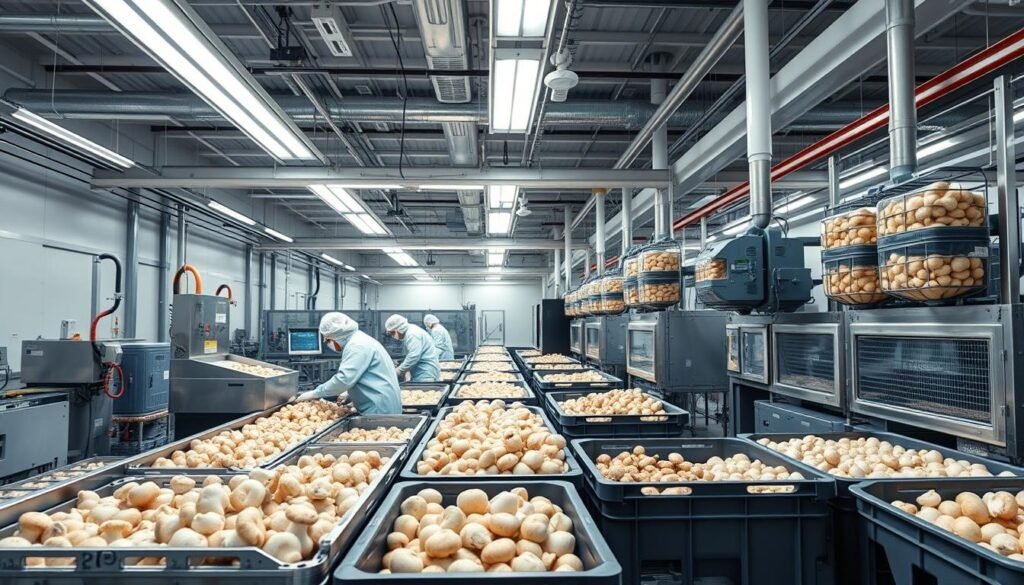
- Temperature control: keeping the right temperature to avoid spoilage and keep flavor and texture.
- Humidity control: managing moisture to keep mushrooms fresh.
- Safety standards: following strict rules for employee safety and product quality.
Using these factors and advanced technology, we make top-quality mushrooms. Our dedication to quality control and pre-processing has made us a reliable mushroom supplier.
Advanced Techniques in Mushroom Processing and Preservation
We’re diving into the latest in mushroom processing tech, focusing on top-notch preservation methods. The global frozen mushroom market is booming, thanks to more people eating vegetarian and vegan. Mushrooms are becoming a favorite meat substitute.
Big names like Bonduelle Group, Monterey Mushrooms, and Greenyard Frozen are leading the market. They offer pre-sliced, pre-washed mushrooms, saving time in the kitchen. These mushrooms last longer than fresh ones, making them a hit with shoppers.
Modern mushroom preservation uses advanced tech like modified atmosphere packaging (MAP). This method keeps food fresh for longer. Companies like CVP Systems Inc. have been perfecting MAP since 1972. They also use calcium hypochlorite systems, which are reliable and accurate for fruit and veg processing.
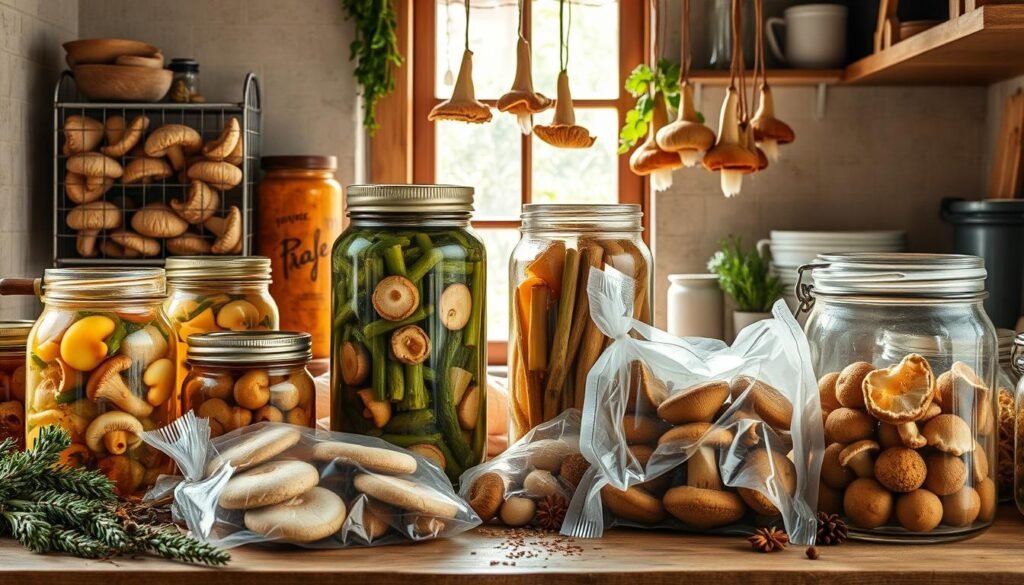
Using calcium hypochlorite can make veggies last longer than untreated ones. It’s also safe for use in fresh-cut processors and lasts longer than sodium hypochlorite. These methods help us make mushroom processing better, meeting the demand for easy, healthy food.
| Company | Technology | Application |
|---|---|---|
| CVP Systems Inc. | Modified Atmosphere Packaging (MAP) | Fresh-cut produce |
| Turatti North America | In-source processing operations | Fruit and vegetable processing |
| Grote | Multi-Slicer | Produce items |
Automated Mushroom Cutting Machines: Revolutionising the Industry
The mushroom processing industry is changing fast with automated cutting machines. These machines use cutting technology for precise and efficient cuts. This leads to better quality products.
The benefits of automated mushroom cutting machines are many. Some key advantages include:
- Increased efficiency and productivity
- Improved product quality and consistency
- Reduced labor costs and enhanced safety
- Enhanced processing systems for better yield and minimal waste
When thinking about getting automated mushroom cutting machines, looking at the return on investment is crucial. With the right processing systems, businesses can save a lot of money and make more profit.
For example, Li An machinery‘s Vegetable/Fruit Dicing Machine is a great example of cutting technology for mushrooms. Using such innovative solutions can change how we process mushrooms. It helps meet the growing demand for quality products.
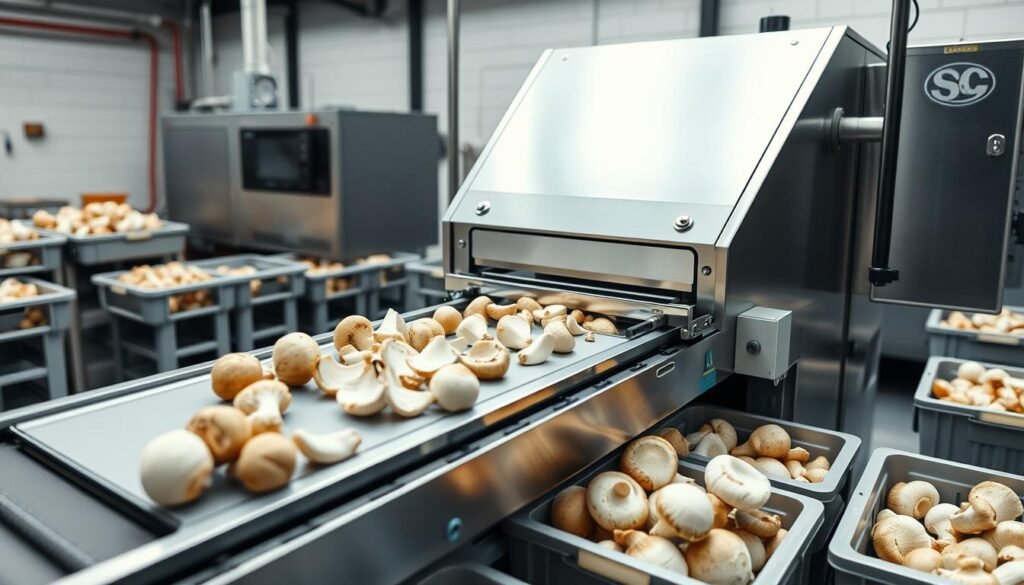
| Machine Type | Benefits | Return on Investment |
|---|---|---|
| Automated Mushroom Cutting Machine | Increased efficiency, improved product quality | Significant cost savings, improved profitability |
| Li An Machinery’s Vegetable/Fruit Dicing Machine | Precise cutting, enhanced safety | High yield, minimal waste |
Maximising Efficiency with Li An Machinery’s Vegetable/Fruit Dicing Machine
We suggest using Li An machinery’s Vegetable/Fruit Dicing Machine for better mushroom processing. It boosts efficiency and quality, perfect for the industry.
The Vegetable/Fruit Dicing Machine from Li An machinery brings many benefits, including:
- Improved efficiency: It can handle big amounts of veggies and fruits fast and accurately.
- Enhanced product quality: Its advanced tech means products are cut evenly and with less waste.
- Increased productivity: Its automated system lets it work non-stop, cutting down on labor costs and boosting output.
Using Li An machinery’s Vegetable/Fruit Dicing Machine helps us be more efficient and produce better products. This makes us stand out in the market. The machine’s cutting-edge tech and automated system are key for any business aiming to boost efficiency and productivity.
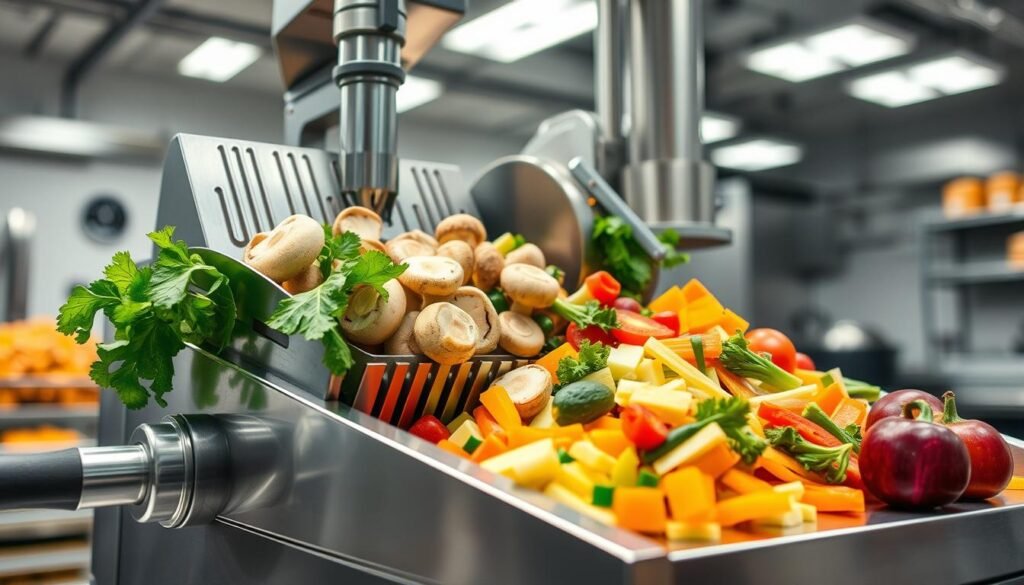
Adopting Li An machinery’s Vegetable/Fruit Dicing Machine is a move towards innovation in mushroom processing. It offers better efficiency and quality, making it a great asset for any business in the field.
| Machine Feature | Benefit |
|---|---|
| Advanced Technology | Improved efficiency and product quality |
| Automated Processing System | Increased productivity and reduced labor costs |
Conclusion: Embracing Innovation in Mushroom Processing
As we wrap up our exploration of mushroom processing, it’s clear that innovation is crucial. The growth of mushroom processing technology has changed how we get, keep, and share these versatile fungi. It’s now easier to get them to people all over the world.
Things like automated cutting machines make work easier. New ways to keep mushrooms fresh for longer have also come along. These innovations have changed the game. Mushroom makers can now make more, waste less, and meet the world’s demand for healthy mushrooms.
We need to keep leading in new tech. By investing in research, we can find new ways to process mushrooms. We can also discover new types and improve how we care for the environment. This focus on innovation will keep the mushroom industry strong and help make our food system better.
Looking ahead, let’s celebrate how far mushroom processing has come. From its old beginnings to the advanced methods we use today. Together, we can make the mushroom industry grow, benefiting our taste buds and the planet.
FAQ
What is the overview of the mushroom processing from harvest to market?
This article talks about mushroom processing, from start to finish. It covers the art and science behind it. We look at the steps from harvest to market and the techniques used.
What is the history of mushroom cultivation and its cultural significance?
We explore mushroom cultivation’s history and its cultural importance. It shows how cultivation has changed, from old ways to new ones. We also look at the lasting impact of traditional methods.
What are the different varieties of commercial mushrooms and their processing requirements?
This section focuses on commercial mushroom types and their needs. It’s important to know each variety’s specific processing needs. This ensures high-quality products.
What is the science behind modern mushroom processing technology?
We dive into the science of modern mushroom processing. It includes pre-processing and quality control. We also talk about temperature and humidity control, and safety standards.
What are the advanced techniques used in mushroom processing and preservation?
We discuss advanced mushroom processing and preservation methods. This includes using automated machines and new preservation ways. These methods improve efficiency and product quality.
What are the benefits of automated mushroom cutting machines?
Automated mushroom cutting machines offer many benefits. They have modern features and can be cost-effective. They could change the industry, like Li An machinery’s Vegetable/Fruit Dicing Machine.
What are the benefits of using Li An machinery’s Vegetable/Fruit Dicing Machine?
Using Li An machinery’s Vegetable/Fruit Dicing Machine has advantages. It boosts efficiency and product quality. It’s a good example of how automation can help the industry.
Source Links
- Perspectives on Novel Technologies of Processing and Monitoring the Safety and Quality of Prepared Food Products – https://www.mdpi.com/2304-8158/12/16/3052
- PDF – https://www.usda.gov/sites/default/files/documents/21amsexnotes2018.pdf
- Foreword – https://www.apo-tokyo.org/wp-content/uploads/2015/11/e-edition_Postharvest-MGT-of-Fruit-and-Vegetables.pdf
- PDF – https://www.americanmushroom.org/clientuploads/directory/mushroom_news/1972/1972_10.PDF
- Growing Gourmet and Medical Mushrooms 9781607741381 – DOKUMEN.PUB – https://dokumen.pub/growing-gourmet-and-medical-mushrooms-9781607741381.html
- Microsoft Word – FrontMatter2.doc – https://etda.libraries.psu.edu/files/final_submissions/4650
- Mushroom Sauce Production Line – IBC MACHINE – https://fruitprocessingmachine.com/mushroom-sauce-production-line/
- Application of Processing and Packaging Hurdles for Fresh-Cut Fruits and Vegetables Preservation – https://pmc.ncbi.nlm.nih.gov/articles/PMC8068883/
- Product | Frozen mushrooms | PMG Engineering | Build World-Class Food Factories – https://pmg.engineering/Product/113/frozen-mushrooms/
- Showcase: Fresh-cut Expo Exhibitors – Produce Processing – https://produceprocessing.net/article/showcase-fresh-cut-expo-exhibitors/

